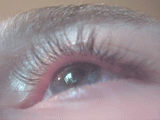Blepharospasm
| Blepharospasm | |
|---|---|
 |
|
| Right Animated image of BFS in the upper eyelid of a 19-year-old male. Symptoms subsided several days later. | |
| Pronunciation | |
| Classification and external resources | |
| Specialty | neurology |
| ICD-10 | G24.5 |
| ICD-9-CM | 333.81 |
| OMIM | 606798 |
| DiseasesDB | 15748 |
| MedlinePlus | 000756 |
| eMedicine | oph/202 |
| Patient UK | [1] |
| MeSH | D001764 |
Blepharospasm is any abnormal contraction or twitch of the eyelid. In most cases, symptoms last for a few days then disappear without treatment, but sometimes the twitching is chronic and persistent, causing lifelong challenges. In those rare cases, the symptoms are often severe enough to result in functional blindness. The person's eyelids feel like they are clamping shut and will not open without great effort. People have normal eyes, but for periods of time are effectively blind due to their inability to open their eyelids. In contrast, the reflex blepharospasm is due to any pain in and around the eye.
It is of two types: essential and reflex blepharospasm. The benign essential blepharospasm is a focal dystonia—a neurological movement disorder involving involuntary and sustained contractions of the muscles around the eyes. The term essential indicates that the cause is unknown, but fatigue, stress, or an irritant are possible contributing factors.
Although there is no cure botulinum toxin injections may help temporarily. A surgical procedure known as myectomy may also be useful. It is a fairly rare disease, affecting only one in every 20,000 people in the United States. The word is from Greek: βλέφαρον / blepharon, eyelid, and σπασμός / spasmos, spasm, an uncontrolled muscle contraction.
Some causes of blepharospasm have been identified; however, the causes of many cases of blepharospasm remain unknown, although some educated guesses are being made. Some blepharospasm patients have a history of dry eyes and/or light sensitivity, but others report no previous eye problems before onset of initial symptoms.
Some drugs can induce blepharospasm, such as those used to treat Parkinson's disease, as well as sensitivity to hormone treatments, including estrogen-replacement therapy for women going through menopause. Blepharospasm can also be a symptom of acute withdrawal from benzodiazepines. In addition to blepharospasm being a benzodiazepine withdrawal symptom, prolonged use of benzodiazepines can induce blepharospasm and is a known risk factor for the development of blepharospasm.
...
Wikipedia
